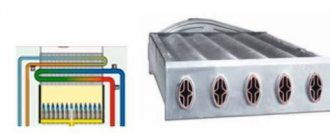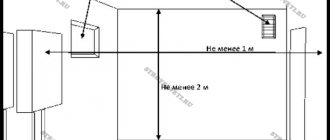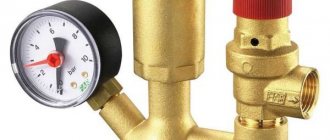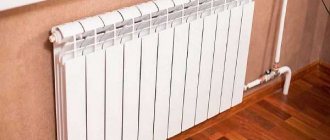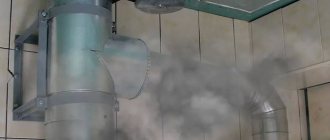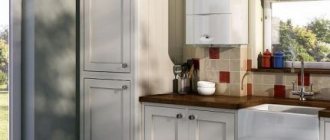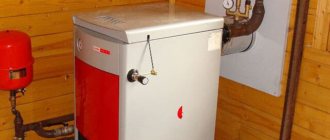The distance between the pipes of heating radiators is determined by building codes. Compliance is essential to ensure your home is safe, provides maximum heating, and complies with the law. What are the consequences of deviation from the rules prescribed in special documents - SNiPe? Will incorrectly installed radiators have negative consequences? This will result in administrative liability for the foreman and the owner of incorrectly installed radiators, and in the worst case, it will lead to a breakdown of the central heating system.
Heating
What rules are prescribed in SNiP regarding the distances between pipes in a living room, greenhouse, etc.? Below are the basic standards that must be observed if radiators are installed in the house.
Types of heating system
Pipeline options
For those who already know what distance between the water supply and gas is recommended to be maintained, the next step to think about is how to properly establish communication with or without support. It all depends on the situation. Options for installing pipelines:
- underground;
- aboveground;
- interior.
Pipe installation
If you need to choose a budget installation method, then the above-ground option is considered the cheapest. It is also advisable to choose products made from high-strength metal.
There are some nuances:
- The open method is suitable for summer cottages and areas around private houses. Pipes are laid above ground when it is impossible to establish gas communications internally. Obstacles can include: reservoirs, ravine, well.
- The internal method involves installation indoors. It is necessary to specifically calculate with gas workers, taking into account SNiP (SP) standards, how many meters between the low-pressure gas pipeline and the water supply it is desirable to observe. The distance according to the classical principle is 1 meter, but in each case the numbers differ. To carry out this communication in the house, you need to use products made of copper or steel.
- When the gasket is closed, a parameter such as gas humidity is taken into account. If wet gas will flow through the pipes, then the pipe is placed at a level where the soil freezes. Structures with dry gas are laid from 80 cm into the ground.
Water supply network at the dacha
Errors in chimney installation
Since it is not always possible to correctly install a stove in a house and route the pipe through the wall, you should consider the most common installation mistakes in order to avoid them. Incorrect robot design is possible in the following cases:
- Insufficient amount of insulation at the junction of elements. In this case, the pipe will overheat.
- The presence of joints where they pass through a wall or roof overhang. Such installation increases the risk of fire in a capital structure.
Rules and regulations
To determine the required distance from the gas pipe, after developing a residential building project, citizens of the Russian Federation apply for the appropriate permit (approval) from the local gas distribution organization. For a definite answer, you need to know the type of gas pipeline and what pressure is used when supplying it. If there is no data on the type of laying and the pressure in the pipes, it is impossible to give an unambiguous answer.
SNiP 42-01-2002 is one of the natural results of the Federal Law of the Russian Federation “On Technical Regulation” No. 184, adopted in December 2002. In November 2008, the Government of the Russian Federation adopted Resolution No. 858, according to which the current sets of rules were developed and approved. This SP was approved at the legislative level in an updated version and was named SP 62.13330.2011.
The most affordable type of fuel has become widespread and has become a publicly available energy resource. Its widespread use has led to the urgent need to develop regulatory documents in which the permitted distances can be found.
Since 2010, SNiP registered by Rosstandart:
- are legislative documents, compliance with which is mandatory;
- checked by supervisory organizations designed to ensure the safety of such structures;
- may be the basis for a decision in a lawsuit;
- are recognized as a significant reason for imposing an administrative penalty upon violation.
SP 62.13330.2011 regulates the distances that must be observed depending on the type of laying of the main gas pipeline or its branches and the pressure of liquid fuel in the pipes.
If gas is supplied in cylinders, only the prescribed fire safety standards must be observed. More economical and volumetric transportation in pipes provides for differentiated requirements for different types of supplies and pressure levels during their implementation.
Communication device
Gas pipes are laid in different ways. The method depends on the task and operating characteristics.
Underground communications are the safest and most common installation method. The laying depth is different: the gas pipeline transmitting wet gas must be placed below the freezing level of the soil, gas pipes moving the dried mixture - from 0.8 m below ground level. The distance of the gas pipeline to a residential building is standardized by SNiP 42-01-2002. The gas pipe can be steel or polyethylene.
- Ground systems - permitted in case of artificial or natural barriers: buildings, water channels, ravines, and so on. Ground-based installations are permitted on the territory of an industrial or large municipal building. According to SNiP, only steel gas pipelines are allowed for overhead communications. The distance to residential facilities is not established. The photo shows an above-ground gas pipeline.
- Internal networks - the location inside buildings and the distance between the walls and the pipeline is determined by the installation of consumer objects - boilers, kitchen equipment, and so on. Laying gas pipes in grooves is not allowed: access to any section of the pipe must be free. Steel and copper products are used to organize internal networks.
In summer cottages, the construction of a ground-based option is commonplace. The reason is the cost-effectiveness of such a solution.
Allowable distances
SNiP 42-01-2002 determines the distance between the house and the gas pipe based on the gas pressure. The higher this parameter, the greater the potential danger the gas pipeline poses.
- A distance of 2 m is maintained between the foundation of an inhabited house and the low-pressure gas pipeline.
- Between gas pipes with an average parameter value and the building - 4 m.
- For the high pressure system the distance is set at 7 m.
SNiP does not regulate the distance between the house and the above-ground structure. However, it establishes a security zone around the onshore gas pipeline - 2 m on each side. The zone must be allocated. Accordingly, when building a house, compliance with this boundary should be taken into account.
Building rules regulate the placement of the gas pipe relative to the window and door opening - at least 0.5 m, as well as the distance to the roof - at least 0.2 m.
SNiP recommendations for gas pipelines are based on fire safety requirements and sanitary standards, so compliance with them is mandatory.
General requirements for construction
Since you can remove the chimney correctly yourself, you should take into account the technological requirements. The cross-section of the smoke exhaust ducts depends on the power of the heating equipment. With lower parameters, draft will deteriorate and combustion products will be removed more slowly.
Placing the pipe inside the box Source petropech.ru
To create normal draft, it is better to use a round chimney. The number of bends should be reduced. The minimum allowed height of the structure is 5 m. If the roof covering is prone to ignition, then a spark arrestor is placed on it in the area of contact with the chimney.
High-quality ventilation is installed near the boiler. The length of the inner part is no more than 1 m, otherwise this area will quickly become clogged with soot and traction will deteriorate. The chimney is equipped with a reservoir to collect accumulated condensate and a window for maintenance. Do not make 90° bends.
Distance from the house to the object outside the fence
When deciding on the placement of a house on a site, they also take into account the distance of the future building to power lines, gas pipelines, railways and cemeteries. This will protect households from traffic noise and fumes from burial sites, and avoid flooding and subsidence of a private building located on excessively wet soil.
Before power lines
To protect the population from electric shock due to accidental deformation of wires, security zones are established on both sides of power lines. Within these areas, housing construction and the construction of dacha and gardening partnerships are prohibited. If a house does end up within the power line, it is not demolished, but a ban on reconstruction and capital construction is imposed.
The minimum distance from the house to the power line depends on its voltage
Compliance with power line security zones also ensures the safety of the electrical network section from fluctuations that occur during the construction of a house. The safe distance from the fence to power lines is determined based on the voltage level and is:
- 35 kV – 15 m;
- 110 kV – 20 m;
- 220 kV – 25 m;
- 500 kV – 30 m;
- 750 kV – 40 m;
- 1150 kV – 55 m.
To the pond
When dreaming of a house near a river or pond, you need to determine whether the purchased plot is included in a water protection zone - land adjacent to a water body with special legal protection. The establishment of a special regime is aimed at preventing pollution, siltation and salinization of the soil, preserving the richness of waters and maintaining the natural biocenosis.
The minimum distance from the house to the river depends on the type of reservoir
Building a house near a pond also carries the risk of its destruction due to its placement on softened soil. When laying the foundation, the width of the water protection zone of a river or sea is taken into account. This territory is determined by the length of the reservoir and is:
- 10 km – 50 m;
- up to 50 km – 100 m;
- over 50 km – 200 m;
- for the sea - more than 500 m.
To the gas pipe
If there is an external gas pipeline on the site, the distance between it and the house must be at least 2 m. The safety distance for underground pipes is determined based on the gas supply pressure. Within populated areas, as a rule, the pressure in the gas pipeline does not exceed 0.005 MPa. In this case, the foundation is laid at a distance no closer than 2 m from the gas pipe.
In the village, a distance of 2 m is sufficient to the low-pressure gas pipe
To the road
In different settlements, the distance between the fence and the road varies. In small villages, as a rule, this figure should be at least 3 m. If the local administration has allowed to deviate from the standards, it is still better to build a fence away from the passage. This will not only protect residents, but also make it easier to access the site.
It is better to stay away from the dust and smells of the road: at least five meters from the fence
When talking about the distance between the fence and the road, the concepts of “road” and “roadway” are distinguished. The first is called a roadbed with a pedestrian zone and a roadside, the optimal distance to which is about 3 m. The second is considered an area for the movement of vehicles. If the land plot is located near highways, the distance to the fence should be at least 5 m.
To the cemetery
The norm for the distance from a cemetery with an area of more than 20 hectares to a residential building is at least 500 m. If the site is located in a village near a small cemetery, the dwelling should be located at least 300 m away from it. For columbariums, memorial complexes, closed burial places, the permissible the distance to the home is 50 m.
The minimum distance to the cemetery is determined by its size
To the railway
The noise and smell from the railway will not please anyone: we are building a house no closer than 100 m
To protect land owners from train noise, the distance from the private sector to the railway must exceed 100 m. If the railway track is located in a depression, or the carrier company has taken measures to ensure noise protection (installed noise barriers, fences), it is permissible to build a house near the tracks, but not closer than 50 m.
We hope that the recommendations outlined will help you make the right choice of placing a house on your own site. In any case, it is better to make sure it is correct by discussing your plans with the local administration and neighbors. Author of the text: Miroshnikov A.P.
In addition to the requirements of Gaznadzor, the installation of a gas boiler in a wooden house must comply with fire safety rules and current building codes. There are restrictions that apply exclusively to wooden buildings.
How to choose a gas meter
So, if you only have a two-burner gas stove, then a G-1.6 meter will be sufficient. A gas stove consumes approximately 1 m3 per hour. If you also have a gas water heater, then it is better to use a meter marked G-2.5. If there are other gas appliances, then the passport of any gas equipment must indicate the gas consumption per hour. Thus, you can calculate what your planned total gas consumption is and then select a gas meter of the required marking.
But in addition to the estimated throughput of the gas meter, it is necessary to take into account such parameters as:
- Direction of gas flow in the meter
- Overall and connection dimensions
- Availability of temperature reading correction (thermal correction)
According to the direction of gas flow, the meters are left-handed (gas flows from the left) and right-handed (gas flows from the right). When choosing a meter, take into account the relative position of the gas pipe and the devices that you are going to connect.
If you are installing a new gas meter to replace the old one or you already have a gas pipeline installed, then you need to know the center distance (A) and thread diameter (F) of the connecting pipes. If the discrepancy in thread diameter can be easily compensated by selecting adapters, then if the interaxial distance does not match, you will have to move the gas pipe or, more likely, buy another meter.
You also need to take into account the distance (E) from the axis of the connecting pipe to the rear wall of the meter because the gas pipe runs at a certain distance from the wall and the meter may not fit in size.
Overall dimensions of the meter
Meters with automatic temperature correction (thermal correction) are initially more expensive than similar meters without thermal correction, but in the future they allow you to save on gas costs. The thing is that meters without thermal correction are designed for gas metering under normal conditions - with an ambient temperature of +20 ° C and a pressure of 760 mm Hg. Art. If the gas is colder, for example in winter, then its density increases, and in summer, on the contrary, it decreases. An increase in gas density leads to the fact that the consumer receives more gas and pays less according to the meter. Therefore, for those who have a gas meter located outside, the temperature coefficient is used in the calculation. In the middle zone for the summer months it is 0.96 - 0.98, and in winter it is about 1.15, and on average for the year it is about 1.1. The coefficient is applied monthly, without taking into account the actual temperature of the supplied gas. The volume of gas payable for a month is calculated as the product of the volume of gas on the meter for a given month and the corresponding temperature coefficient. To avoid disagreements when paying for gas, it is better to install a meter with a thermal corrector, which will automatically determine gas consumption in accordance with its actual temperature. This is especially true for those who consume increased volumes of gas, for example, for heating a cottage and heating water.
For those who have a meter in their apartment, the use of a thermal corrector is also relevant and allows you to save money. After all, in fact, the temperature in the kitchen is higher than +20°C, especially when the gas stove is on, so the density of the gas is lower than normal. Consequently, the thermal corrector will “slow down” the meter.
Video description
This video clearly shows an example of violation of the rules for installing a sandwich chimney:
- The position of the pipe is not observed. It is installed strictly vertically. When insulating main walls with foam plastic or mineral wool, long dowels are used to secure the chimney.
- There is no ebb on the side roof slope. In this case, precipitation can get on the insulation and impair its functions.
- Insufficient overall vertical height. This error leads to poor traction.
Problems arise when using low-quality insulating material. Cheap insulation shrinks over time, so there is a possibility of local overheating of some parts of the chimney.
Rules for placing pipes and sockets in relation to the gas pipe
Often the cause of accidents and emergencies is a violation of the simplest safety rules for installing electrical wiring, one of which is the norms for the distance of electrical wiring relative to pipelines.
A set of rules for the construction of electrical installations (PEU) developed by specialists from the Ministry of Energy allows us to fully answer the question: at what distance from the gas pipe can a cable be laid and an electrical outlet installed.
The distance from the electrical outlet to the gas pipe - what the standards regulate
The rules for safe installation of electrical wiring are regulated by the main regulatory document - PUE-6; they apply to installed and operated electrical installations with alternating current voltage up to 750 kW. The rules have been developed taking into account the implementation of planned and preventive tests and repairs of electrical installations over which technical supervision has been established.
Distance from gas pipeline to outlet
The distance from the socket to the gas pipe is established by the regulatory act of the Ministry of Energy PUE-7, clause 7.1.50, which regulates the clearance between electrical switches, electrical sockets and the gas pipe to be at least 500 mm.
Rice. 3 Selection criteria and methods for laying exposed electrical wires and cables
Rules for placing pipes and electrical cables
When installing electrical networks, a distinction is made between internal and external wiring; in the first version, it is placed in the structure (grooves) or niches of building structures and separated from the surface by fireproof materials - concrete, plaster, cement-sand mortar, alabaster, gypsum binder. The thickness of the insulating layer of hidden wiring made of non-combustible building materials is regulated by the PEU only for cases of nearby products made of combustible components; according to the rules, the insulating layer should not be less than 100 mm.
PEUs regulate in more detail the standards for the distances of open wiring to pipes through which explosive gases circulate. According to the requirements of regulatory documents (PUE-6 clause 2.1.56), the permissible clear distance between electrical wires without protection or in protective insulation and pipes with neutral substances must be at least 50 mm. If explosive gas passes through the main line, the clearance is made more than 100 mm .
If the distance from electrical cables to pipes is less than 250 mm, it is mandatory to protect the wiring from mechanical impacts for a length of at least 250 mm on both sides of the gas pipe.
When laying an electric cable and pipes with a neutral working substance in parallel, the clearance between them is made at least 100 mm. If the electric line runs next to a gas pipeline, the distance between the gas pipe and the wire should be more than 400 mm.
If the design of the premises involves the intersection of laid hot pipelines with electrical wiring, the latter must have suitable heat-resistant insulation or have external protection against high temperatures.
Rice. 4 Electrical wiring installation methods depending on the type of premises
When carrying out renovation work in an apartment, a situation often arises when you need to move an electrical outlet in the kitchen or lay new wiring. In this case, electrical installation work must be carried out in accordance with generally accepted requirements and rules (REU), developed by specialists taking into account repeatedly tested safety standards.
Heating of non-residential premises (greenhouse)
In non-residential spaces, the rules for installing pipes are less strict. Practical benefits rather than safety are taken into account here. Polypropylene and metal pipes are laid according to strict regulations only if they conduct gas, which is used to heat the greenhouse. Water radiators and polypropylene pipes are not subject to strict regulations unless it is a commercial site.
The optimal distance between heating pipes in a greenhouse is a gap of 120 mm, where there are no trays with plants. Such passes help to evenly warm the soil without drying it out. Parallel laying is the most effective. With it, the greenhouse will produce the most fruit, since the trays are heated evenly.
It's time to replace the gas meter
When is it time to change the meter?
Each meter has a verification period. Usually this time is from 8 to 10 years. The first verification takes place at the time of installation of the meter. Thus, the verification time falls exactly in the middle of the device’s service life.
If the meter is in good working order and measures the readings correctly, then it is left in operation for another period. And if the readings are not accurate, then the gas meter must be replaced.
You were told to install a meter of a certain brand, what should you do?
No one can oblige you to install a specific brand of gas meter. The service organization is obliged to accept from you any metering device certified in the Russian Federation. The main thing is that the technical requirements are met.
What technical requirements must be taken into account when choosing a gas meter?
- Counter volume. Usually this parameter appears directly in the name of the counter after the letter “G”. For example G4, G6, G10. The larger the volume, the greater the throughput.
- Thermal correction. The meter can be installed both in a heated room and outdoors. Outdoor temperatures can vary by 80-90 degrees throughout the year. Therefore, it is necessary to install a thermal corrector in street meters to correctly account for consumed gas. This parameter also usually appears in the name of the meter and is designated by the letter “T”. G4 - without thermal corrector, G4T - with thermal corrector.
- Distance between centers of gas supply pipes. This parameter can be measured using a ruler. Standard distances between pipe centers for household gas meters: G4 – 110 mm G6 – 200 or 250 mm G10 – 250 or 250 mm
- Gas inlet direction. Stand facing the meter display. If the gas inlet pipe is on your left, it means the gas supply is from left to right. If on the right hand, then from right to left.
- Thread diameter. The pipes through which gas flows must be hermetically sealed in the meter. And if the diameter of the pipe is, say, 40 mm, and the thread on the meter is 32 mm, then of course they will not meet at the junction. But unlike the problem of non-standard distance between pipes, the problem with threads is quite simply solved with an adapter nozzle.
Which brand of counter should I choose?
There is no clear answer here. Call us at 8-962-957-32-80, we will advise you and help you with your choice.
Expert advice
Before purchasing the necessary materials for arranging an external chimney, the power of the equipment is determined. It affects the diameter of the pipes. You can also use these expert tips:
- if the heating equipment is equipped with forced draft, then it is not necessary to increase the vertical section of the structure; it is enough to remove the horizontal pipe;
- a horizontal section that is too long helps slow down the smoke flow (the value should not exceed 1-1.5 m);
Rules for installing chimney pipes Source krovgid.com
Inspection openings are installed not only on the outer part of the structure, but also on the internal horizontal element.
Classification by gasket type
Transportation of gases is carried out using different types of gas pipelines; the material used to make the pipes, the need for construction of gas pipeline supports, and the distance to various objects may depend on this:
- Underground gas pipelines are constructed of polyethylene or steel; the first type of material prevails, which is resistant to corrosion and does not require protective measures.
- Steel pipes are used for above-ground gas pipelines; utility networks are designed taking into account the necessary supports, gas compressor stations, and the need for permanent repairs.
- The construction of above-ground highways is cheaper than the first two, but also requires expensive technical support to comply with safety rules, taking into account ensuring safety from damage that may be caused by human or natural factors.
- Underwater ones are also not cheap - taking care of the safety of the work costs a lot; design taking into account seismic conditions and distance from transport routes requires specific skills.
Laying a medium pressure gas pipeline
In any case, the laying of a gas pipeline is carried out in accordance with the current legislation of the Russian Federation and the standard distance from buildings and structures to the gas pipeline. The equipment must comply not only with safety regulations, but also take into account the boundaries of zones of a certain length, environmental protection measures, land use - and all this depends on the categories.
The “Rules for the Protection of Gas Distribution Networks” determine special zoning and standard distances at which proximity to various structures is permitted. The standards for installing gas filling stations are contained in SNiP 2.07.01-89 “Urban planning. Planning and development of urban and rural settlements" and SP 42.13330.2011.
Gas supply to the building
Watch the video below on this topic.
Technical characteristics of sandwich pipes
- Material. Basalt fiber (mineral wool) is mainly used as a thermal insulation material. This type of insulation is resistant to high temperatures and chemicals. Mineral wool has excellent thermal insulation/sound insulation properties and is laid with a thickness of 30-60 mm. Due to their fireproof properties, multilayer pipes can be used in houses built from any material. More expensive alloys with a high degree of heat resistance are used for the inner casing.
The inner layer of the sandwich pipe is mainly made of galvanized steel, and the outer layer can be made of copper, brass, stainless steel, etc. The scope of the pipe and the price depend on the content of alloying materials, various alloys and the thickness of the heat-insulating layer.
Sandwich pipes galvanized and stainless steel
- Connection type. Sandwich pipe elements are connected in two ways: corrugated edges and sockets. The advantage of a corrugated connection is ease of installation, but to ensure tightness, a large amount of sealant is required, and this increases the cost of the chimney. With a socket connection, a high degree of tightness is achieved due to the presence of a wider chamfer on one side of the pipe. The advantage is a high degree of tightness, due to which the design can be used for gas boilers. But the downside is the complexity of installation and the need for very precise adjustment of all parts.
Types of sandwich pipe connections
